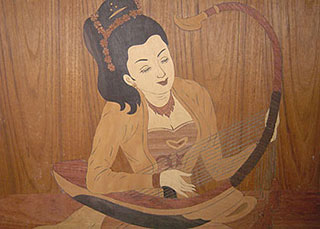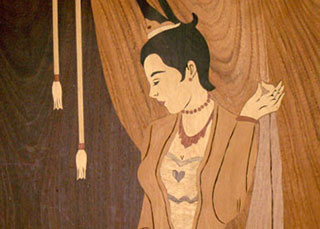The Veneer – Painting Inlaid work of variously coloured woods is called Parquetry (Parqueterie). It is the art of producing articulately rich and soul touching pictures in veneer-jointed format which is overlaid on plywood by glue bond.


Historical Background
Historical findings have provided evidence of ancient Parquetry works utilized by the Pharoahs of Egypt. going back more than 5000 years. It was also widely used in Greece and Rome. Documentry evidence shows that the furniture and cabinets used by Napolean I were decorated with ancient Parquetry in the 19th century.
In Myanmar. we refer to it as Thit-parr-hlwar ba-gyee; the veneer-painting. This art work was introduced by the No.1 Plywood Factory. in Kyimyindine Township. Yangon. The factory was founded by former George Bah Oh (Bah Oh Teak and Hardwood Co. Ltd.) in 1956. It was nationalized on 5-10-64 and operated by State Timber Board (later reorganized as the Timber Corporation on 15-3-71).
Junior Assistant Officer U Tun Lin was the artificer of Parquetry production. He discovered veneer-painting technique on his own without any outside help. and he later mastered the material to perfection. His success in veneer-painting was largely due his improvisation and creativity in making pictures for souvenirs. Thence. his ingenuity in using wood pieces to create painting-like pictures gained reputation in the wood-base industry circles.
Plywood researcher Mr. Baldwin said that. plywood technology is derived from portrayal of articles. In this respect plywood production is a fine art. But. in using innovative and modern production methods in plywood production then it becomes a scientific technology. To promote Parquetry production on a commercial scale the Managing Director of the Timber Corporation (now the Myanma Timber Enterprise ) opened a Parquetry section in 1979. The section is a small one manufacturing downstream value-added products for domestic and export markets.
The main objectives of the Myanmar Timber Enterprise in parquetry manufacture are as follows:-
- To shed glimpses on the style and culture of Myanmar;
- To promote utilization of wood waste from ply and veneer mill;
- To gain income from added value.
Veneer Utilization – Understanding of the colour and appearance of wood is. indeed. of great benefit to many woodmakers. Choice timber species use for making quality authentic fine art of veneer-painting. each with its own special purpose. include :-
- Teak( Tectona grandis)
- Background. floor and outer frame.
- Magyi pway(Diospyros pendula)
- Background.frame to portray face. hands. legs. shawl and
Hta-main(Sarong of lady).
- Yemane( Gmelina arborea )
- Petty coat and Hta-main(Sarong).
- Binga ( Mitragyna rotundifolia )
- Jacket of lady.
- Padauk (pterocarpus macrocarpus)
- Floor. bracelet and neck lace.
- Thinwin (Millettia pendula)
- Hair of lady and black elephant.
- Thitkhaya(Diospyros oblonga); Cream white surface pattern is mixed with black linings.
- Background and elephant’s body.
- Hnaw (Adina cordifolia)
- Light and dark yellow robe of monk.
- Taukkyan (Terminalia tomentosa)
- Body of elephant and buffalo.
It is also valuable for foreign buyers who can experience the characteristic qualities and natural colours of Myanmar hardwood species.
Efficient Processes
Traditional designs and representatives of Myanmar. Western and Eastern life and culture are ideal for veneer-painting. First of all. some sketches of the designer are necessary to be translated into Parquetry . Neat and skilful drawings are cut with cutter-a sharp knife or scissors. Edges of the parts are joined and composed with veneer tape. one after the other to complete a full scene. This stage is an important factor in the process. It has to be accomplished with great care and patience. In each cautiously cut and composed veneer figure. there is accurately highlighted. movement and their slight attenuated forms. makes the art particularly delightful. Composed veneer-painted pictures are glue bonded on a piece of plywood and put in the hot ppress machine. After that. pictures are cut out by a small circular sawing machine. Then. they are scraped clean and the rough surface is rubbed with sandpaper for finishing -to get Parquetry products with fine detail and some delicate colours.
Size and Design Normal picture sizes are 7.6 x 10.0 ; 10.0 x 12.0 (Brief size) ; 15.0 x 19.0 ; 19.0 x 28.0 ; 20.0 x 30.0 or any order size. Stimulating superb large size Parquetry products are decorated with ornately curved teak frames. The art of arranging linnes. shape and details in a pattern is amazing. Some beautiful designs are popular ; viz. “Elephant Power”. “Oil Lamp Dance”. “Royal Princess”. “Playing Myanmar Harp”. “Great Wall” and “Santa Claus”. The most amazing is the workmanship of the portraits of famous persons. The portrait of princess Maha Chakri Sirindhorn (Thailand) is remarkable. There are also Parquetry wall clocks of multi colour rays and assorted backgrounds; fascinating trays. highly interesting ceilings and fancy plywood for wall decoration.
Domestic Use
Unique and fascinating Parquetry workmanship is an organic part of the decoration of large architectural ensembles like “Thiripyitsaya Hotel” in Bagan and “Tatmadaw Dhammayon” (community hall for religious purpose) in Yangon.
Display
Masterpieces with traditional designs of the world and representatives of Myanmar life and culture were displayed at the International Trade Fair: Beijing (2-8-93) and Myanmar Trade Fair: Tachileik (21-12-93). The decorative veneer of various species harmonized gracefully with the splendid designs of Parquetry in the show rooms and aroused the admiration of exhibition goers.
Souvenir
US blobe girdling pilot Mr. Thomas Claytor who arrived here on 27-8-98. was impressed by Myanmar’s developmennt. ancient heritages and forest conservation. He was presented with a gift of Parquetry as souvenir by authorities concerned. Mr. Graham Bird. the captain of M.V Doulos ship. who paid a visit and donated technology books. was given a gift of a large size Parquetry painting by Secretary-1 of the State Peace and Development Council. Lt. Gen Khin Nyunt on 15-12-98.
Special Demand
There was a domestic order to portray the International Business Centre. Yangon: for the Asia-Pacific Forestry Commission; Sixteenth Session. held from 15-20 January 1990. It was accomplished as specified and sent through the Ministry of Forestry.
Conclusion
Although plywood is the Factory’s principal business. there is diversity of commodity like veneer flitch and Parquetry . The latter is vital place within the ambit of the factory’s responsibilities . Myanmar Timber Enterprise has been ardently striving to develop the wood-base industry and give subtle boost to production of artistic Myanmar wooden products like Parquetry .San Win (Mann.)
